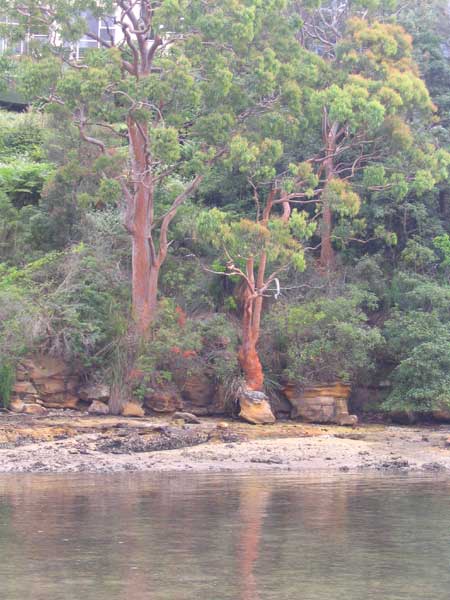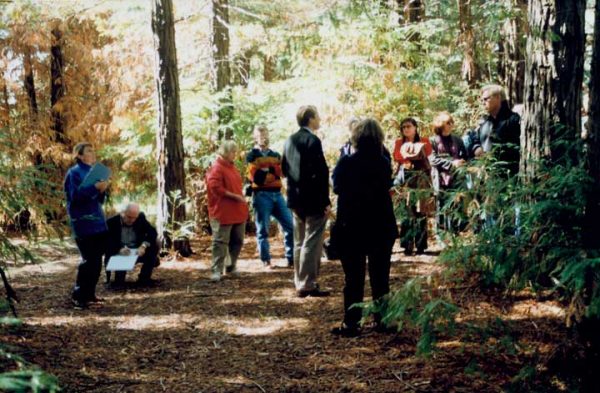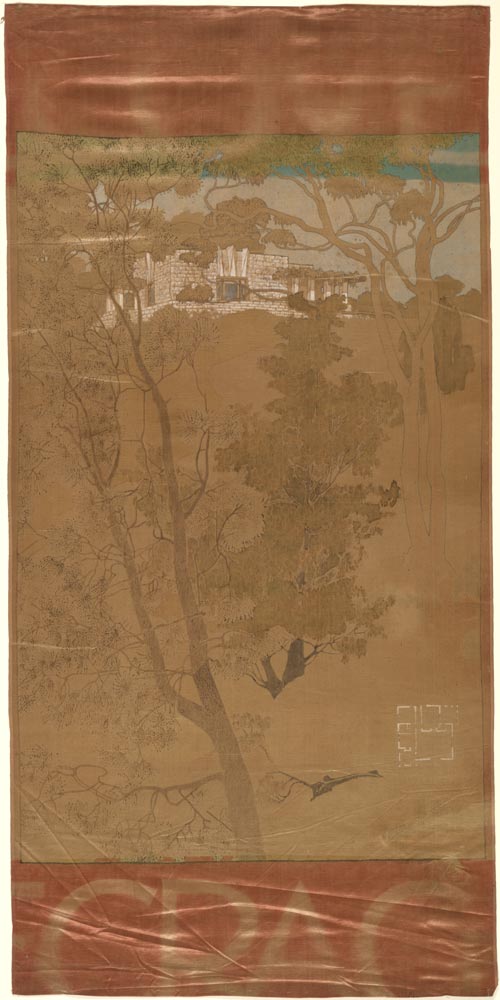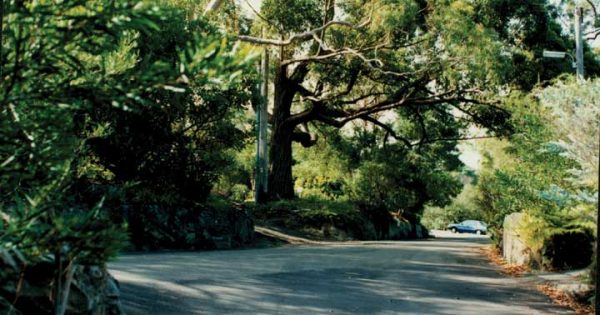The Griffins before coming to Australia had taken great interest in the landscape and vegetation of the countryside near Chicago. Both Marion Mahony Griffin and Walter Burley Griffin demonstrated a remarkable sensitivity towards the natural environment, and this was transferred to their newly found interest in the characteristics of Australian native vegetation. One only has to see Marion Mahony’s fine silk drawings included in their submission in the competition for the design of our capital Canberra to appreciate their sensitivity towards the Australian flora. Her superb drawings are outstanding and are even more remarkable when we realise that eucalyptswere not cultivated in Chicago as the winters are so severe. Many of her drawings often associated with Walter Griffin’s Australian architectural plans illustrate a range of species of Eucalyptus as well as Angophora, Banksia and other native plants.
Walter Griffin on entering Sydney Harbour by ship for the first time was entranced by those areas of the foreshore where native forests came to the water’s edge. Later he was to comment on the unacceptable destruction of foreshore vegetation further up the harbour. He was equally scathing in his comments on the unimaginative layout and lost opportunities in the sub-division of many of Sydney’s suburbs.
Canberra
In the Griffins’ concepts for Canberra it is clear that they had great respect for the surviving post-agricultural native vegetation. However Griffin was not a purist when it came to planting new vegetation. Certainly both the Griffins supplemented plant cover with native species, sometimes local and sometimes from elsewhere in Australia, but they also appreciated the beauty of plants from other countries.
It was the skilled blending of native and introduced plants into streetscapes, parks, reserves and gardens by local horticulturalists and botanists that has given the Capital, Canberra, both an Australian and international setting of outstanding interest and beauty.
Griffin while working on the implementation of the Canberra plan established a Portuguese Cork Oak plantation that has now reached productive maturity. He also in another part of Canberra established a plantation of the two species of North American giant Redwoods; this unfortunately was partly damaged by the Canberra fires in 2003. Another of his plantations of Italian Cypress was destroyed by the same fires.
Castlecrag
After he left the Canberra project, Griffin had the opportunity to sub-divide and begin developing the rugged peninsula that today is the suburb of Castlecrag on an area of the foreshore of Sydney’s Middle Harbour. He put forward his strongly held view that in such a sensitive harbour foreshore residential development the built environment must be subservient to the natural bushland and sandstone outcrops characterising this district. Hence not only were the roads, pathways, easements and bush reserves carefully planned, but also the majority of building sites enjoyed bushland settings in this natural landscape.
It is recorded that the Griffins were so incensed by the cutting of the native wildflowers on the peninsula, already degraded on the upper plateau area by the tree destruction for firewood, that they formed with their pioneer residents vigilante patrols to prevent further environmental damage.
Many sites enjoyed either views or glimpses of Middle Harbour. Griffin ensured that many kilometres of Middle Harbour natural bushland foreshore were free of buildings although many sub-divisions extended to the water’s edge. His imaginative naming of the roads, reserves, pathways and some other features of the rugged and steep peninsula of Castlecrag using the terminology of the European medieval castle accurately reflects their position as if this was a real castle.
The Griffins would not have been able to predict the weed problems today from both native and introduced species. Some serious weeds, although present in the Sydney region in the Griffins’ time, were not then suspected as weeds. Botanists only recently have come to realise that weedy species often only develop a weedy habit after some years of slow development. Privet, African Olive and Camphor Laurel are good examples of introduced weedy plants, as are Pittosporum undulatum and some species of Acacia from the Australian flora.
Had the Griffins recognised these and other potential problem species they would probably have resisted their introduction to this area; they may also have laid out some reserves in different ways so as to reduce the ‘edge effect’ in the battle to beat these unwanted invaders.
Clearly the Griffins were far ahead of their time in environmental concern. They would be disappointed to see that electric power is still delivered by a maze of overhead wires and power poles. They had urged underground power reticulation 70 years ago! Equally they would be angered by some of the ‘mega’ houses that have been squeezed onto the sub-divisions. They would be saddened by the invasion of weeds in some areas but they both would be delighted with the emergence of bushcare groups and the support of both volunteers and professionally trained council workers.
To appreciate the Griffins’ design features in the Sydney suburb of Castlecrag, walking the roads, as well as some pathways and reserves, is essential. Enjoy the bushland setting as well as the diverse architecture especially that which touches the land gently. Be sure to visit the Griffin designed Haven Valley Scenic Theatre, a beautiful amphitheatre with its generous stage, a bush and harbour backdrop, and stone terraces for seating the audience in a native bush setting.
Detail from Cheok Hong Cheong dwelling, Castlecrag, Sydney. Depicts the sandstone house nestled within its bushland setting of Lookout Reserve. Illustration on silk which although unsigned is likely to be by Marion Mahony Griffin. National Library of Australia PIC/7453
Bushland and a Tallowwood Eucalyptus microcorys likely to have been planted by the Griffins beside the Sortie Port road at Castlecrag
Author
Professor Carrick Chambers AM, formerly Professor of Botany at the University of Melbourne from 1966 to 1986, was Director of the Royal Botanic Gardens, Sydney from 1986 to 1996. He served on the committee of the Walter Burley Griffin Society Inc, and is now the Patron of the Society. He has been a resident of Castlecrag since 1986.




